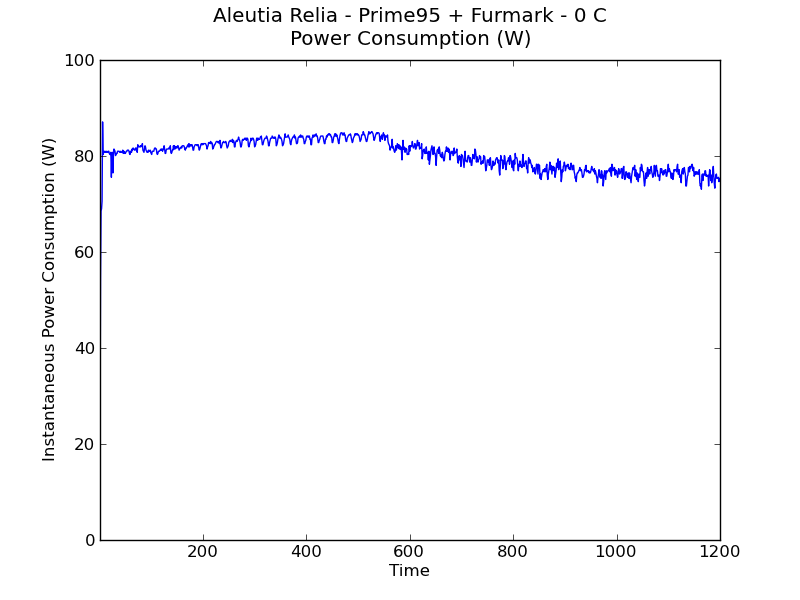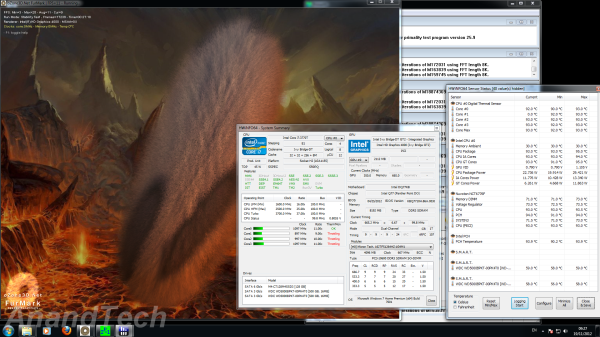Aleutia Relia Industrial PC Review: Ivy Bridge & Q77 in a Fanless Chassis
by Ganesh T S on December 4, 2012 10:00 AM EST- Posted in
- Industrial PC
- HTPC
- Ivy Bridge
- Aleutia
Thermal Performance:
One of the drawbacks of completely passively cooled systems is that the CPUs reach their maximum temperature much faster than actively cooled systems. The CPU throttles down its performance as soon as the limits are reached. We proceeded to test out the thermal performance by loading up both the CPU and GPU with Prime 95 and Furmark. After hitting the thermal limits, the CPU speeds were throttled to 900 MHz.
One of the points to note in the above screenshot (taken with the unit at room temperature - 72 F) is that the chassis becomes hot enough for the HDDs to report a temperature of 59 C. This is even without any hard drive activity in the loading process. 55 - 60 C is considered the maximum permissible temperature for hard disks to ensure reliable operation. It doesn't seem advisable to use mechanical hard disks in the system if it is expected that the workloads for the system would end up throttling the CPU. We pinged Aleutia about this, and they indicated that the advisable ambient temperature for our test system was 30 C (for a pure SSD only solution, they upped it to 33 C). They also indicated that the i3-based system could go higher in terms of ambient temperature, but didn't mention specifics. For users with a requirement for operation at higher ambient temperatures, Aleutia indicated that they have custom solutions available too.
Our next plan of action was to determine the efficiency of the thermal solution under the above constraints. To test this out, we placed the unit in a temperature chamber and recorded the power consumption under full load. As soon as throttling hits, the power consumption of the unit starts to drop. We repeated the test with the temperatures at 0 C, 15 C and 30 C. After each run (i.e, subjecting the unit to full loading and letting the CPU cores reach the Tjmax of 94 C), we let it idle for 30 minutes. The core temperatures after the idling with the ambient at different temperatures are provided below.
| Aleutia Relia Cooling Efficiency | |
| Ambient Temperature | Core Temperature 30 min. after Tjmax |
| 0 C | 31 C |
| 15 C | 36 C |
| 22 C | 39 C |
| 30 C | 51 C |
The power consumption graphs are provided below for the unit's operation over a 20 minute duration after the start of the loading process.

The thermal solution works very well at low temperatures, with throttling kicking in after 9 minutes or so. With rising ambient temperature, the throttling kicks in within 3 minutes (at 30 C). These graphs are with absolutely no air flow in the temperature chamber, and are hence, worst case scenarios.
At 30 C, we also have detailed graphs of the temperature, load and frequency for one of the cores. These were generated by CoreTemp 1.0 RC4.












47 Comments
View All Comments
Sikku - Wednesday, December 5, 2012 - link
http://www.mini-box.com/DC-DCganeshts - Wednesday, December 5, 2012 - link
The DQ77KB mITX board has a DC input (mentioned in the review). So, only a AC - DC adapter is needed and no explicit PSU.We have the Streacom Nano150 in-house for use in our upcoming HTPC testbed. It looks very similar to the pico PSU that you have linked below.
Sikku - Wednesday, December 5, 2012 - link
Ok.. Waiting for that review.. :)Hood6558 - Wednesday, December 5, 2012 - link
I don't get it, what's the point of buying a fast CPU installed in a case that takes it to max temp in 3 minutes under any kind of load, and then throttles it back to a lousy 900 MHz? This is "industrial" design? I wonder how long the CPU actually survives under that kind of stress. My guess is a lot of heat-related failures are in the near future of anyone foolish enough to buy one of these somewhat expensive doorstops.ganeshts - Thursday, December 6, 2012 - link
It really depends on the workloads. I doubt users purchasing this unit are going to run Prime 95 + Furmark as their daily workload 24 x 7.Rollo Thomasi - Thursday, December 6, 2012 - link
But then what is the point of an i7 if you are not going to use it?Why not go for a cheaper cooler running CPU?
The only point would be if you have a need to do a lot of short intensive bursts Wright? Then the CPU could work at top speed without throtteling.
Notmyusualid - Thursday, December 6, 2012 - link
And I shall buy one to make a bad-ass wifi AP & caching server (when I get the time).Lowest-end i3, an old SSD,and Squid running on some linux distro, and that should do the trick I reckon. I also have a 3x3 MIMO Card lying around so would likely install a 3rd antenna.
With my ISP now 100M/10M, I've been reluctant to try this without dual GigE ports, and a completely passive cooling solution, AND without looking like an eye sore in the living room.
But the price man...